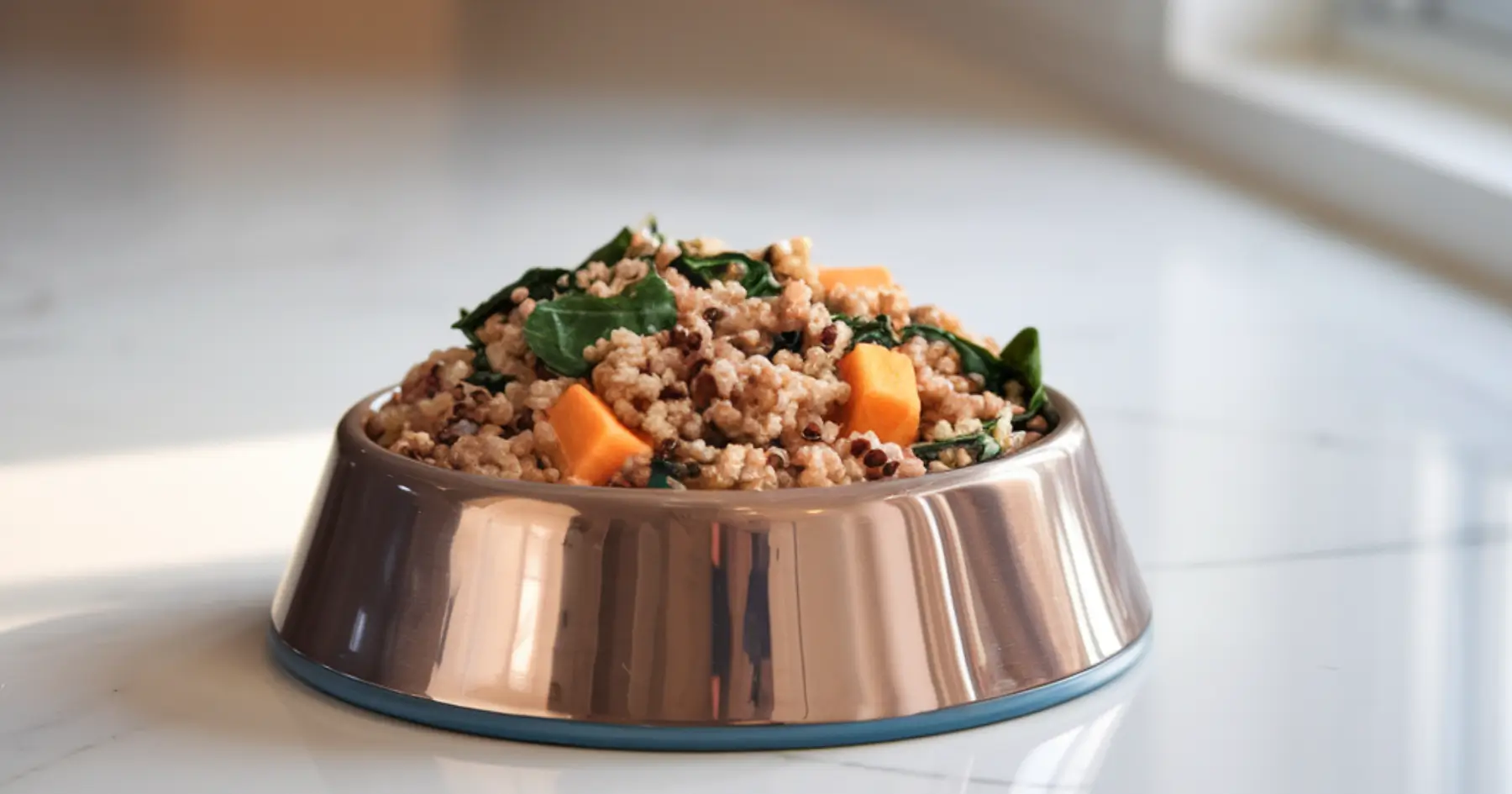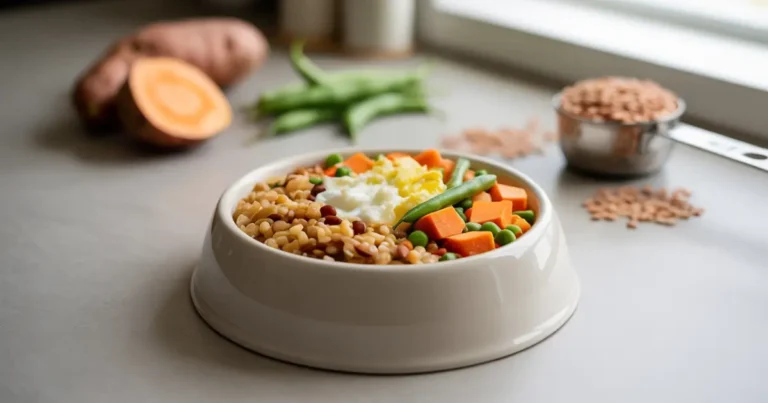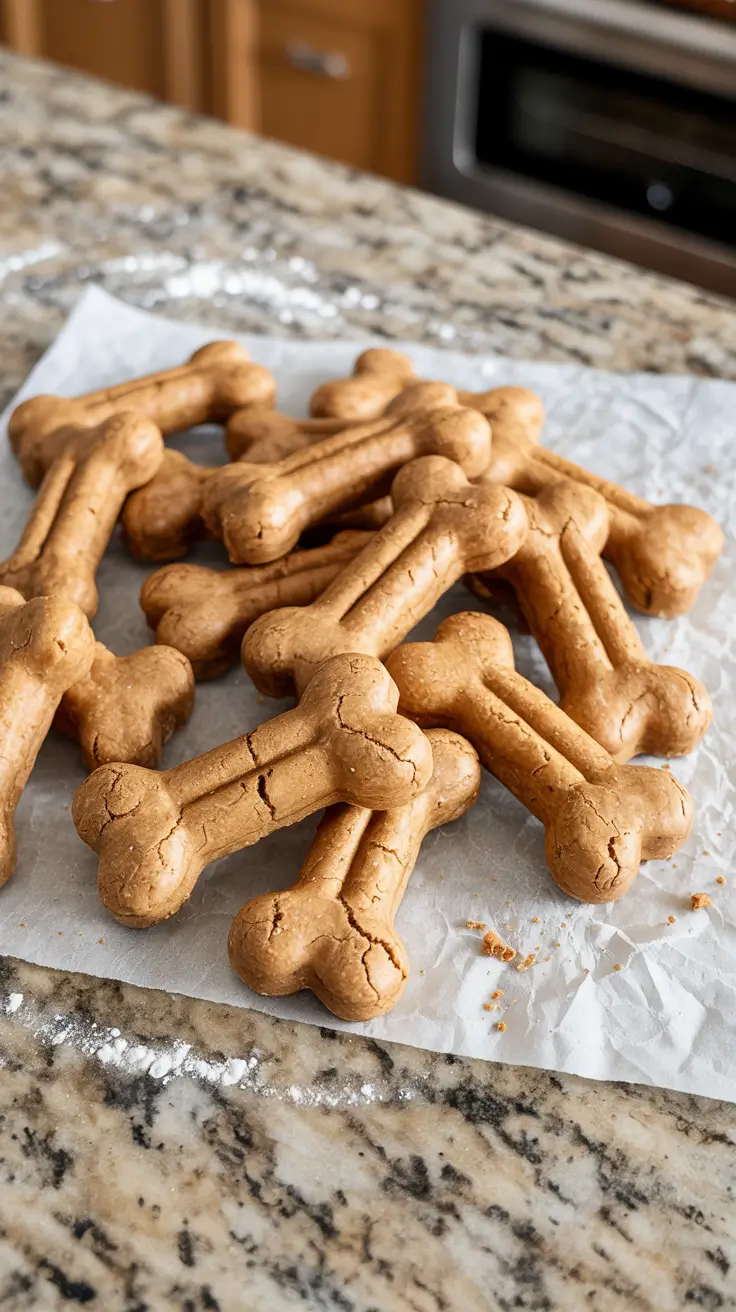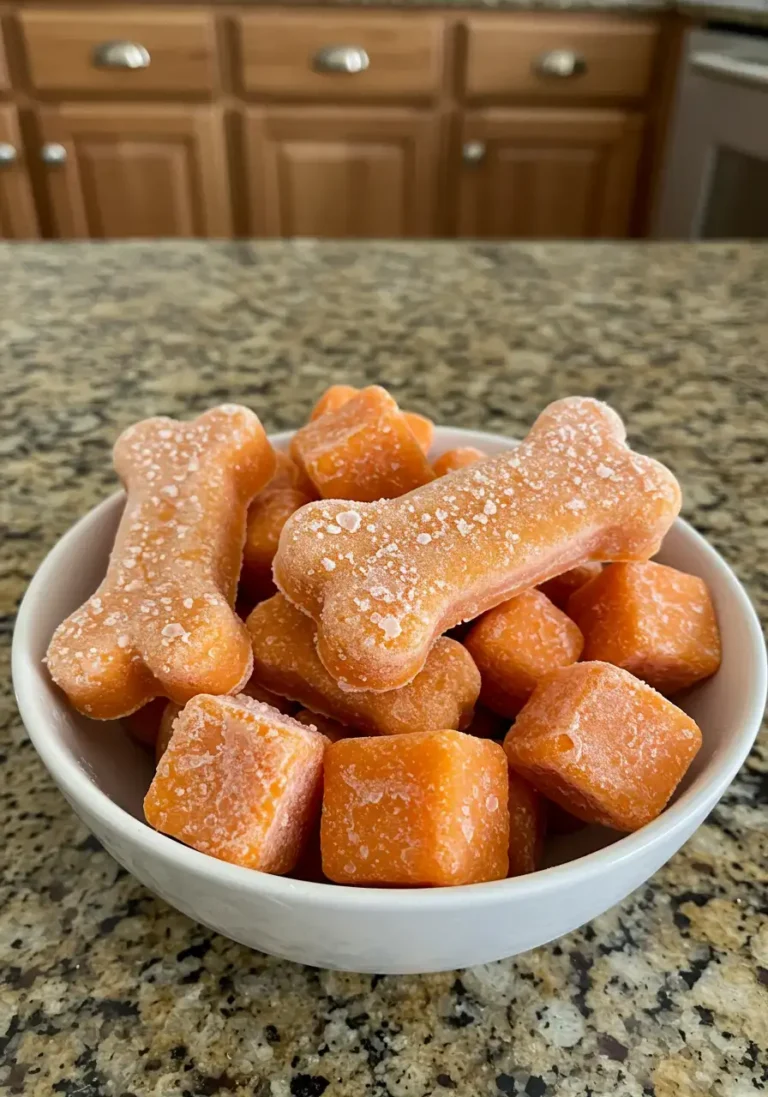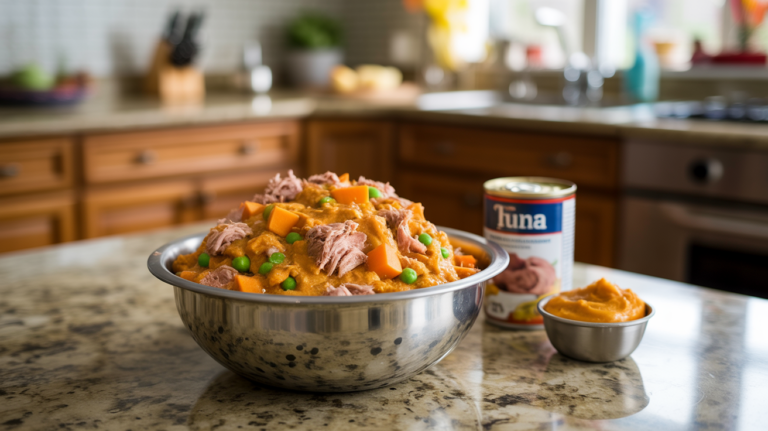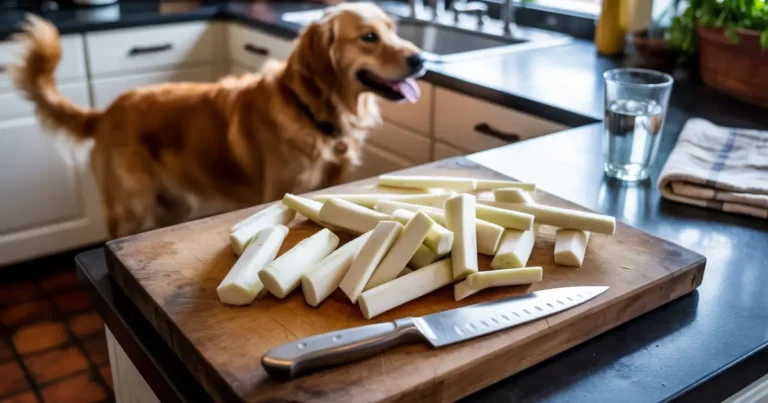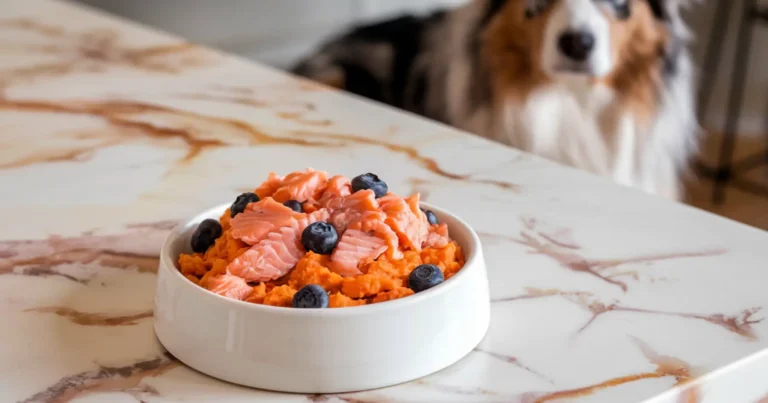Turkey and Quinoa Dog Food for Allergies: 5 Easy Steps
If your dog has been struggling with food allergies, finding the right meal that doesn’t trigger uncomfortable symptoms can feel overwhelming. Many commercial dog foods contain multiple proteins, grains, and additives that can overwhelm sensitive digestive systems. This turkey and quinoa dog food recipe offers a gentle, healing solution designed specifically for dogs with allergies.
As part of our comprehensive guide to homemade dog food recipes for allergies, this minimal ingredient dog food approach provides an excellent option for managing your dog’s sensitivities. This grain free turkey dog food combines just five carefully selected ingredients to create a nutritious, easily digestible meal that supports healing while avoiding common triggers.
Table of Contents
Why Turkey and Quinoa Work Perfectly for Allergic Dogs
When dealing with food allergies, choosing the right ingredients can make all the difference in your dog’s comfort and health. This turkey and quinoa dog food combination works exceptionally well because it addresses the root causes of allergic reactions while providing complete nutrition through a minimal ingredient dog food design.
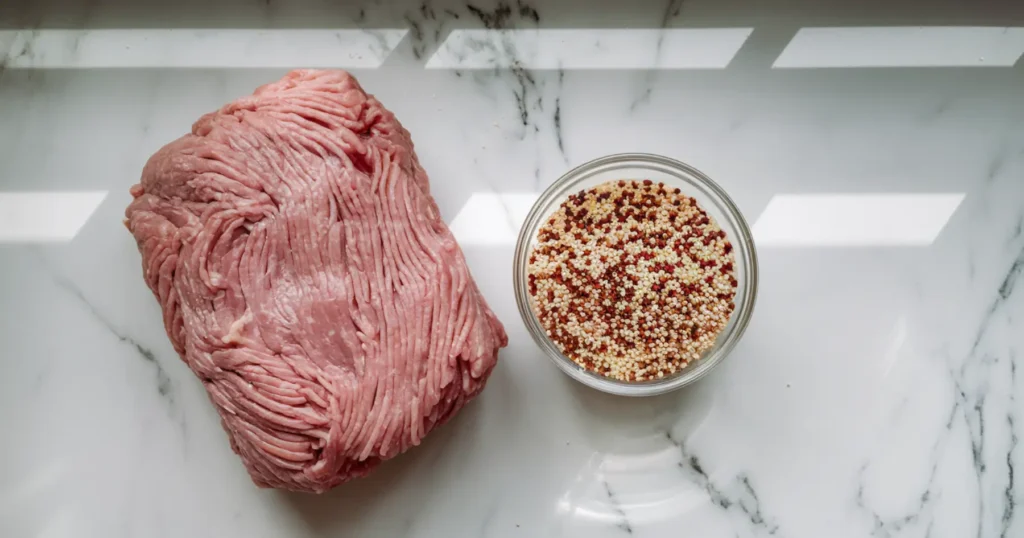
Turkey: A Gentle Novel Protein Source
Turkey is regarded as a novel protein for the majority of dogs, making it a great option for dogs with allergies. Unlike chicken, beef, or lamb that appear in countless commercial foods, turkey dog food remains relatively uncommon in typical dog diets, meaning your dog is far less likely to have developed a sensitivity to it.
From a nutritional standpoint, turkey is remarkably lean, containing approximately 25 grams of protein per 100 grams while maintaining low fat content. This makes turkey dog food easier for sensitive stomachs to process while still delivering the essential amino acids your dog needs for muscle maintenance and immune function. Turkey also provides important minerals like phosphorus for bone health, selenium for antioxidant protection, and B vitamins for energy metabolism.
Quinoa: The Perfect Hypoallergenic Carbohydrate
Is quinoa good for dogs with allergies? Absolutely. Quinoa offers unique advantages that make it ideal for sensitive dogs. Unlike traditional grains such as wheat, corn, or rice that frequently trigger allergic reactions, quinoa is technically a seed from the Chenopodium quinoa plant.
This grain free turkey dog food approach eliminates common allergens while providing complex carbohydrates for sustained energy. Is quinoa good for dogs long-term? Yes, quinoa contains all nine essential amino acids, making it a complete protein source that complements the turkey beautifully in this turkey and quinoa dog food recipe. The anti-inflammatory properties of quinoa can help reduce existing allergy symptoms over time.
Complete Turkey and Quinoa Recipe for Dogs with Allergies
This carefully formulated turkey and quinoa dog food recipe provides complete nutrition while maintaining the simplicity that minimal ingredient dog food requires. Each ingredient serves a specific purpose in supporting your allergic dog’s health and recovery.
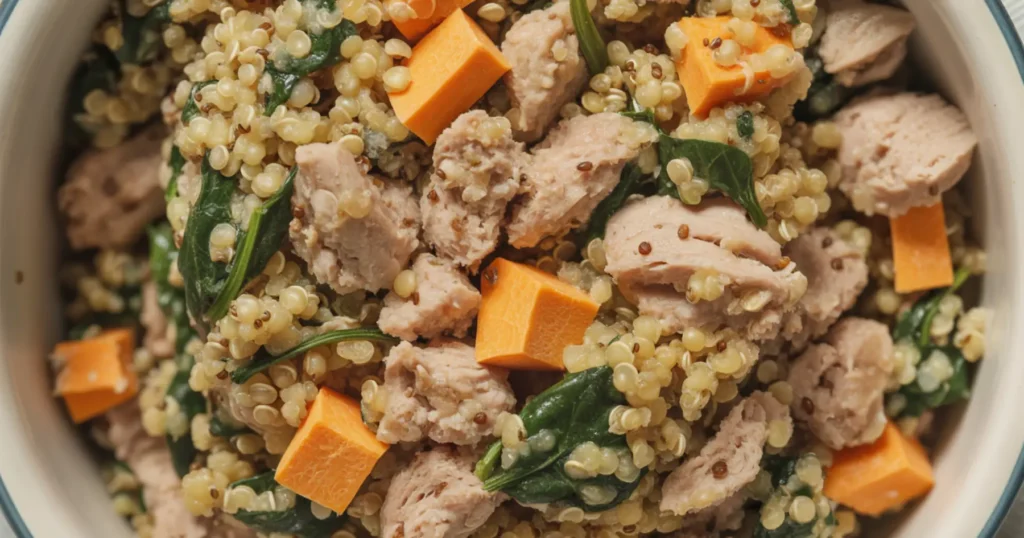
Recipe Quick Facts
- Prep Time: 15 minutes
- Cook Time: 30 minutes
- Total Time: 45 minutes
- Yield: 8-10 cups (feeds 50-75 lb dog for 4-5 days)
- Storage: Refrigerate 4 days, freeze 3 months
- Calories: Approximately 45-50 per ounce
Ingredients
| Ingredient | Amount | Nutritional Purpose |
|---|---|---|
| Ground turkey (93% lean) | 2 pounds | Primary protein source, muscle maintenance |
| Quinoa (organic, rinsed) | 1 cup dry | Complex carbohydrates, additional protein |
| Sweet potato (medium) | 1 piece (8 oz) | Beta-carotene, fiber, natural sweetness |
| Fresh spinach | 2 cups chopped | Healthy fats, coat health, and antimicrobial |
| Coconut oil (unrefined) | 2 tablespoons | Healthy fats, coat health, antimicrobial |
Equipment Needed
- Large heavy-bottomed pot or Dutch oven
- Medium saucepan with tight-fitting lid
- Fine-mesh strainer for quinoa
- Sharp knife and cutting board
- Large mixing bowl
- Airtight storage containers
Nutritional Information (Per Cup)
- Protein: 12-15 grams
- Fat: 3-4 grams
- Carbohydrates: 8-10 grams
- Fiber: 2-3 grams
- Calories: 360-400
Special Instructions for Allergy Management
- Always rinse quinoa thoroughly under cold water for 2-3 minutes until water runs clear to remove saponins that can cause digestive irritation
- Use only fresh, high-quality ingredients and avoid any seasonings, oils, or additives beyond those listed
- Cook all ingredients thoroughly to ensure food safety and optimal digestibility for sensitive systems
- Never add salt, garlic, onions, or other seasonings that can be harmful to dogs
- Allow all ingredients to cool completely before combining to prevent nutrient loss
- To preserve freshness and avoid contamination, store in airtight containers.
5 Steps to Prepare This Healing Turkey and Quinoa Recipe
Follow these detailed steps to create this healing grain free turkey dog food that will provide gentle nutrition for your allergic dog.
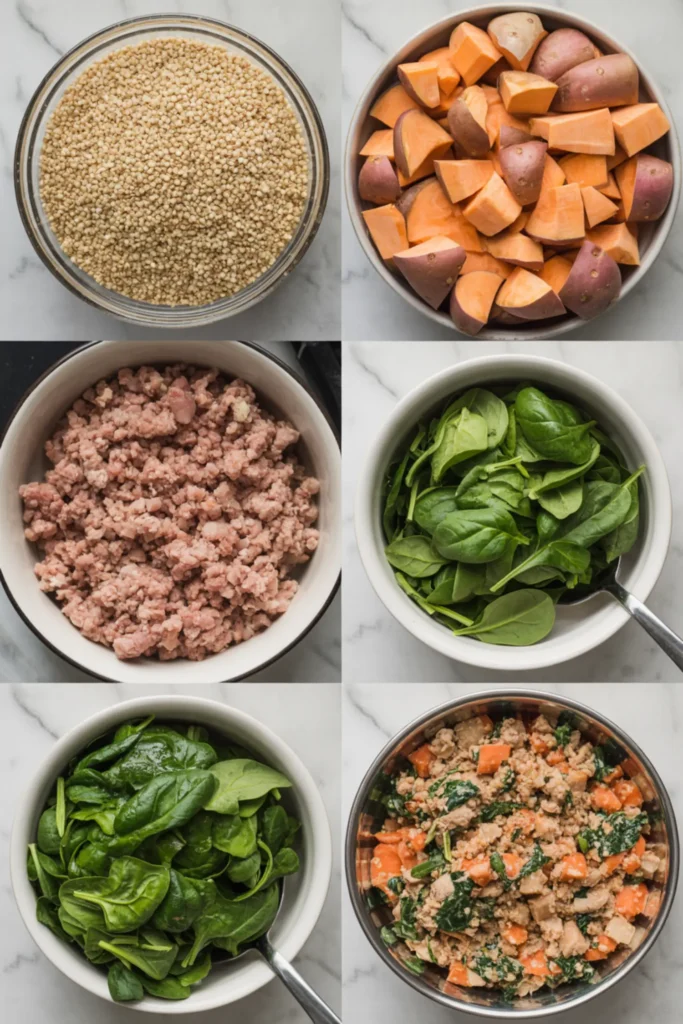
Step 1: Prepare and Cook the Quinoa
- Measure one cup of quinoa into a fine-mesh strainer
- Rinse thoroughly under cold running water for 2-3 minutes, agitating with your hands
- Continue rinsing until the water runs completely clear to remove the saponin coating
- Combine rinsed quinoa with 2 cups of fresh water in a medium saucepan
- Bring to a boil over medium-high heat, then immediately reduce to low
- Cover tightly and simmer for 15 minutes
- Remove from heat and let stand 5 minutes before fluffing with a fork
- Set aside to cool completely
Step 2: Prepare the Sweet Potato
- Wash and peel the sweet potato thoroughly, removing any eyes or blemishes
- Cut into small, uniform cubes approximately ½-inch in size for even cooking
- Place cubed sweet potato in a medium saucepan and cover with water
- Bring to a boil and cook for 10-12 minutes until fork-tender but not mushy
- Drain well and set aside to cool
- Sweet potato should hold its shape while being soft enough to mash easily
Step 3: Cook the Ground Turkey
- Heat a large pot over medium heat without adding any oil
- Add ground turkey and begin breaking it apart with a wooden spoon
- Cook for 8-10 minutes, stirring frequently for even cooking
- Ensure no pink remains and internal temperature reaches 165°F (74°C)
- Meat should be cooked through but not dried out
- If excess liquid accumulates, continue cooking until most of the moisture evaporates
Step 4: Add Sweet Potato and Spinach
- Add cooked sweet potato cubes to the turkey and gently stir to combine
- Cook for 2-3 minutes to warm the sweet potato through and allow flavors to meld
- Add chopped fresh spinach to the pot and stir gently
- Cook for just 1-2 minutes until spinach wilts completely
- Spinach should retain a bright green color – don’t overcook to preserve nutrients
Step 5: Combine Final Ingredients and Cool
- Remove the pot from the heat before adding the cooled quinoa
- Gently fold quinoa into the turkey and vegetable mixture for even distribution
- Add coconut oil while the mixture is still warm so it melts evenly
- Mix thoroughly to ensure the oil coats all ingredients
- Allow the entire mixture to cool completely to room temperature
- Portion into airtight containers for storage
Serving Guidelines and Transitioning to Your New Recipe
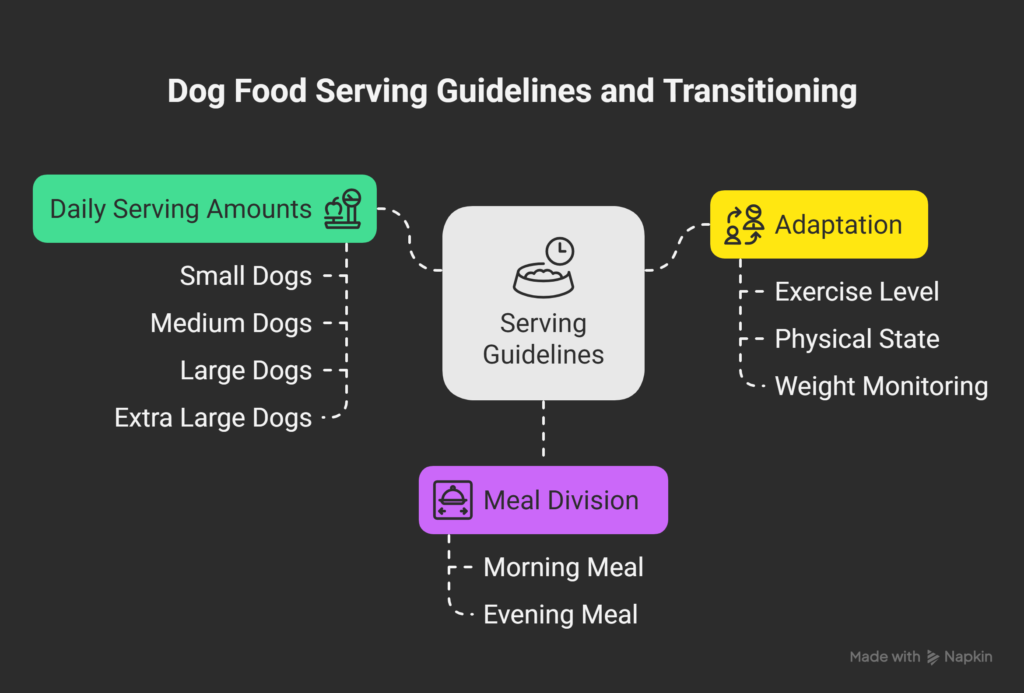
Proper portion sizes ensure your dog receives adequate nutrition from this turkey and quinoa dog food without overeating. Use these guidelines as a starting point for your minimal ingredient dog food portions, then adjust based on your dog’s individual needs.
Daily Serving Amounts by Weight
- Small Dogs (10-25 lbs): ½ to 1 cup per day
- Medium Dogs (25-50 lbs): 1 to 2 cups per day
- Large Dogs (50-75 lbs): 2 to 3 cups per day
- Extra Large Dogs (75+ lbs): 3 to 4 cups per day
- Divide daily portions into two meals (morning and evening)
- Adapt to your dog’s level of exercise and physical state.
- Monitor weight and increase or decrease portions as needed
Transitioning Schedule
- Days 1-2: 25% new food, 75% current food
- Days 3-4: 50% new food, 50% current food
- Days 5-6: 75% new food, 25% current food
- Days 7-10: 100% new food
- Monitor closely during transition for any digestive upset
- Slow the process if any stomach issues occur
- Maintain the current ratio for additional days before proceeding if needed
- Never switch allergic dogs to a new food overnight
Monitoring Your Dog’s Response to the New Diet
Tracking your dog’s response to this turkey and quinoa dog food helps you determine its effectiveness and identify any remaining sensitivities. Since is quinoa good for dogs varies by individual, monitoring is essential.
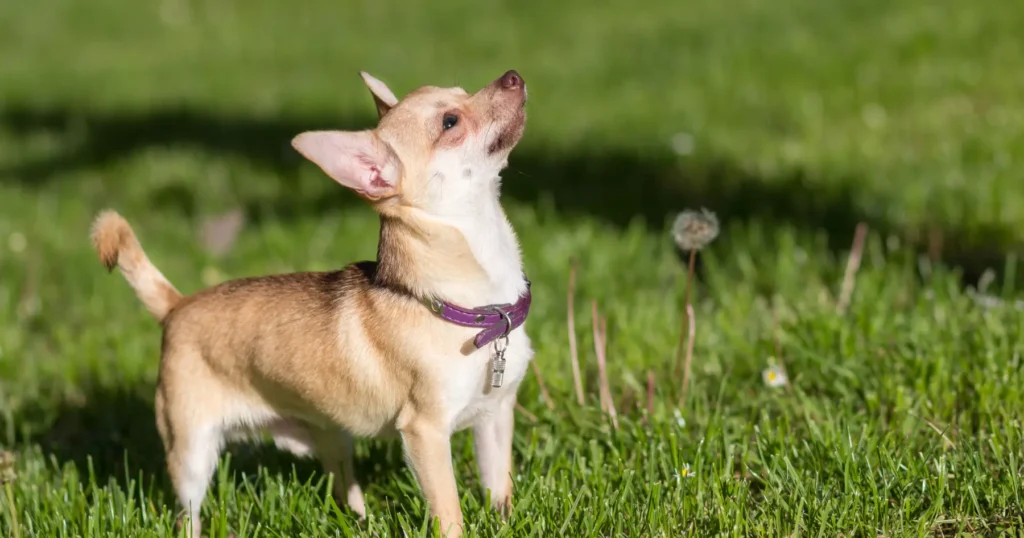
Signs of Improvement to Watch For
- Reduced scratching and skin irritation
- Shinier, healthier coat texture
- More formed, regular bowel movements
- Increased energy and playfulness
- Better appetite and meal enjoyment
- Clearer, more alert eyes
- Less paw licking and chewing
- Improved overall mood and behavior
- Reduced ear scratching or head shaking
Warning Signs to Address
- Continued or worsening skin irritation
- Digestive upset lasting more than 48 hours
- Loss of appetite or unexplained weight loss
- Excessive gas or bloating
- Changes in water consumption (drinking much more or less)
- Lethargy or significant behavioral changes
- Vomiting or diarrhea that persists
- New or worsening ear infections
- Get in touch with your veterinarian right away if any of these happen.
Alternative Limited Ingredient Options for Dogs with Allergies
While this turkey and quinoa dog food works well for many dogs, some may need different options based on their specific sensitivities. If your dog doesn’t respond well to turkey, consider hypoallergenic diet options with duck and potato, which provide similar benefits with different protein sources.
Some dogs also benefit from salmon and sweet potato recipes that offer anti-inflammatory omega-3 fatty acids. For dogs with multiple protein sensitivities, homemade vegan dog food options using ingredients like lentils and vegetables might be worth exploring under veterinary guidance, especially for dogs with skin allergies. Dogs with sensitive stomachs might do better with lamb and rice combinations, which tend to be very gentle and easily digestible.
Enhancing Your Dog’s Recovery with Supportive Care
In addition to nutrition, using this minimal ingredient dog food will hasten your dog’s recovery from food allergies through several supporting measures.
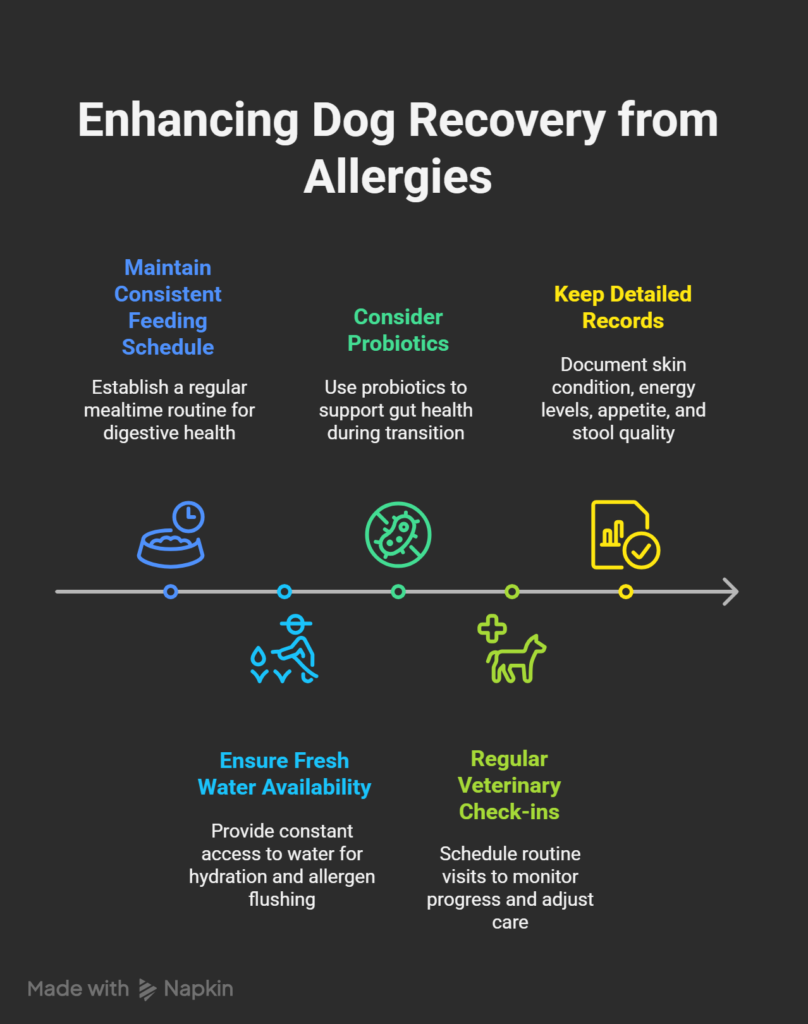
Environmental and Stress Management
Maintain a consistent feeding schedule to support digestive health, feeding meals at the same times each day. Ensure fresh water is always available, as proper hydration supports skin health and helps flush allergens from the system. Consider probiotics specifically designed for dogs to support gut health during the transition.
Working with Your Veterinary Team
Regular check-ins with your veterinarian help monitor progress and make necessary adjustments. Keep detailed records of your dog’s skin condition, energy levels, appetite, and stool quality to share with your vet. This information proves invaluable for tracking improvements and identifying any concerns early.
Key Takeaways for Success with Turkey and Quinoa Dog Food
- Turkey and quinoa dog food provides gentle nutrition for dogs with food allergies using grain free turkey dog food principles
- This minimal ingredient dog food approach eliminates common allergens while maintaining complete nutrition
- Understanding is quinoa good for dogs helps you make informed decisions about this turkey dog food recipe
- Proper preparation, including thorough quinoa rinsing, ensures optimal digestibility
- Gradual transition over 7-10 days prevents digestive upset in sensitive dogs
- Keep thorough notes for your doctor and keep a careful eye on your dog’s reaction.
- Always get your veterinarian’s approval before making big nutritional adjustments.
Conclusion: Healing Your Dog with Anti-Inflammatory Nutrition
Creating homemade turkey and quinoa dog food for your allergic dog represents a powerful step toward better health and comfort. This carefully crafted grain free turkey dog food recipe eliminates common triggers while providing the complete nutrition your dog needs to thrive.
The anti-inflammatory properties of this minimal ingredient dog food combination, along with understanding is quinoa good for dogs with allergies, can help your dog’s immune system reset and heal. With patience and consistent monitoring, many dogs experience significant improvement in their allergy symptoms within just a few weeks of starting this turkey dog food recipe.
FAQs
How long should I feed this turkey and quinoa recipe exclusively?
Most dogs benefit from feeding this turkey and quinoa dog food exclusively for 8-12 weeks to allow their system to fully heal. However, consult with your veterinarian about the appropriate duration for your specific dog’s needs and whether additional proteins should be introduced gradually.
Can I substitute ingredients if my dog shows sensitivity?
Yes, but make substitutions carefully and one at a time. Replace turkey with duck or lamb if needed, sweet potato with pumpkin, or consult your vet about alternative carbohydrates if quinoa doesn’t suit your dog. Always introduce new ingredients gradually.
Is this recipe nutritionally complete for long-term feeding?
While this turkey and quinoa dog food provides excellent nutrition, dogs on homemade minimal ingredient dog food long-term typically need vitamin and mineral supplements. Talk to your veterinarian about including supplements manufactured especially for homemade dog food.
What if my dog refuses this new food initially?
Some dogs need time to adjust to new textures and flavors. Try warming the grain free turkey dog food slightly, mixing in low-sodium bone broth, or offering smaller portions more frequently. If refusal continues beyond 3-4 days, consult your veterinarian.
How should I store this food, and for how long?
Store in airtight containers in the refrigerator for up to 4 days or freeze individual portions for up to 3 months. Always thaw frozen food overnight in the refrigerator before serving, and never leave it at room temperature for more than 2 hours.
References and Resources
The information in this article is based on guidance from veterinary professionals and pet nutrition experts. For additional information about feeding dogs with allergies and quinoa safety, consult these trusted resources:
American Kennel Club (AKC) – Expert advice on dog nutrition, including quinoa safety and feeding guidelines for dogs with food allergies.
PetMD – Veterinary-reviewed information on dog nutrition, food allergies, and safe ingredients for homemade dog food.
Hill’s Pet Nutrition – Research-based guidance on canine nutrition and dietary management for dogs with special needs.
Spot Pet Insurance – Veterinary-approved information on safe foods for dogs and nutrition guidelines.
Always consult with your veterinarian before making significant changes to your dog’s diet, especially if your dog has food allergies or other health conditions.
Your Dog Tried It? Drop a Review Below!
There are no reviews yet. Be the first one to write one.

